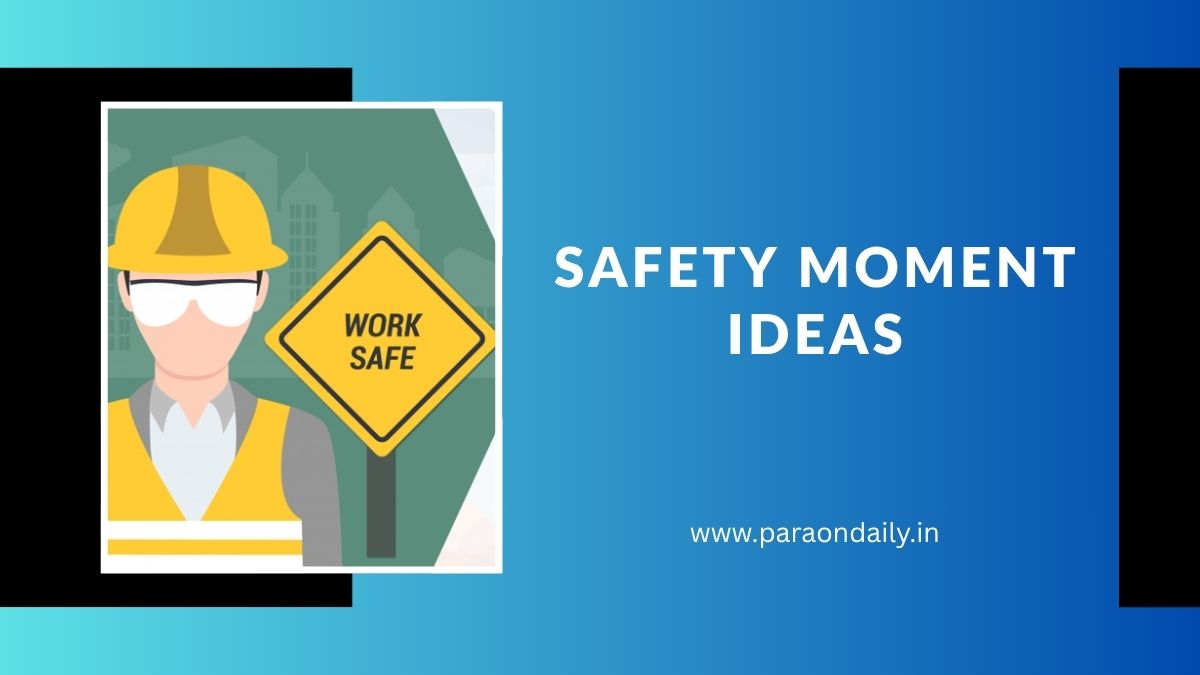Safety is something we should all think about every day—at work, at home, and even on the road. Talking about safety regularly helps us stay alert and prevent accidents. That’s where safety moment ideas come in. A safety moment is a short talk or reminder about safety that helps people stay careful and aware of risks. These moments can happen at the beginning of a meeting, a work shift, or even during training. They take just a few minutes but can save lives.
In this blog, we will share safety moment ideas that are useful for workplaces, schools, and homes. These ideas are easy to understand, simple to follow, and will help you build a strong safety culture wherever you are.
What Are Safety Moment Ideas?
Safety moment ideas are short topics or reminders shared to improve safety awareness. A safety moment usually lasts 2–5 minutes and focuses on one safety tip or issue. It is often shared before a meeting or work shift to help people stay careful and avoid accidents. These talks can cover many topics such as fire safety, personal protective equipment, hygiene, electrical safety, or even mental health.
The goal is simple: to remind everyone to stay safe and follow best practices. Safety moment ideas are not just for big factories or offices—they are helpful at schools, hospitals, construction sites, or even at home. The most important part is that the message is clear, short, and easy to act on. These ideas can be repeated regularly to create a habit of safety thinking in daily life.
Also read: Non Profit Organisation Project Ideas
77 Safety Moment Ideas
Here is a list of simple and useful safety moment ideas you can use at your workplace, school, or home:
General Workplace Safety
- Always wear proper personal protective equipment (PPE)
- Keep walkways and work areas clean and free from clutter
- Never run in the workplace
- Know your emergency exits
- Follow all warning signs and instructions
- Do not use broken tools or machines
- Report unsafe conditions immediately
- Be careful when lifting heavy items—use your legs, not your back
- Take breaks to avoid tiredness and stress
- Use handrails when going up or down stairs
Electrical Safety
- Do not use damaged cords or wires
- Never touch electrical devices with wet hands
- Unplug devices when not in use
- Avoid overloading power sockets
- Keep liquids away from electronics
- Only trained people should fix electrical problems
- Know where the electrical shut-off is
- Use surge protectors
- Test electrical equipment before use
- Report sparks, smells, or strange sounds from equipment
Fire Safety
- Know where fire extinguishers are located
- Learn how to use a fire extinguisher (PASS method)
- Keep fire exits clear
- Do not block sprinklers
- Store flammable materials properly
- Don’t use candles or open flames in work areas
- Practice fire drills regularly
- Know your building’s fire evacuation plan
- Don’t smoke in no-smoking areas
- Turn off electrical items at the end of the day
Health and Hygiene
- Wash hands regularly
- Cover coughs and sneezes
- Stay home when feeling sick
- Clean your workspace daily
- Keep first aid kits fully stocked
- Drink enough water during the day
- Eat healthy and avoid junk food at work
- Use hand sanitizer when needed
- Dispose of waste properly
- Avoid touching your face
Mental Health and Wellness
- Take breaks to relax your mind
- Talk to someone if you’re feeling stressed
- Avoid multitasking too much
- Get enough sleep
- Do light stretches during long working hours
- Balance work and personal life
- Show kindness and respect to coworkers
- Encourage a positive work environment
- Practice deep breathing during stress
- Laugh and smile—it’s good for health
Home Safety
- Keep floors dry and clean to avoid slips
- Lock away cleaning chemicals from children
- Install smoke detectors and check batteries
- Store sharp tools like knives safely
- Use ladders properly
- Keep a first aid kit at home
- Don’t leave the stove unattended
- Check gas connections regularly
- Turn off appliances before going to bed
- Teach kids about emergency phone numbers
Road Safety
- Always wear a seatbelt
- Don’t use phones while driving
- Follow speed limits
- Use crosswalks when walking
- Keep headlights clean and bright
- Check your vehicle before long trips
- Avoid driving when tired
- Never drink and drive
- Keep a safe distance from other vehicles
- Always wear a helmet when riding a bike
Seasonal Safety
- Drink more water in summer to avoid heatstroke
- Dress warmly in winter
- Be careful of slippery roads during rain
- Watch out for firecrackers during festivals
- Use sunscreen in hot weather
- Check heaters before use in winter
- Stay indoors during storms or lightning
How to Create and Use Safety Moment Ideas Effectively
Now that we’ve shared useful safety moment ideas, let’s look at how to create and use them effectively. A good safety moment should be relevant, short, and easy to understand. Here are some helpful tips:
1. Keep it Practical
Choose safety topics that match your work environment or situation. For example, talk about machinery safety in a factory, or hand hygiene in a healthcare setting.
2. Use Real-Life Examples
People understand and remember stories. If someone got hurt due to skipping safety steps, share the story (without blaming) and explain how it could have been prevented.
3. Get Everyone Involved
Don’t make safety a one-person task. Invite team members to share their own safety tips or stories. This builds engagement and makes safety part of your culture.
4. Use Visuals or Props
Sometimes showing is better than telling. Bring a pair of safety gloves, a fire extinguisher, or a worn-out wire to make your point stronger and more memorable.
5. Make It a Routine
Choose a regular time to have safety moments—before meetings, every Monday, or at the start of every shift. Repetition helps build habits.
6. Keep It Positive
Instead of only pointing out dangers, also highlight safe behavior. Appreciate team members who follow safety rules well.
Also read: Mlk Service Project Ideas
Conclusion
Safety is not just a one-time thing—it should be a part of our daily life. By using safety moment ideas, we can help ourselves and others stay careful, alert, and protected from danger. These short talks remind us of simple steps we can take to avoid accidents and stay healthy. The safety moment ideas shared in this blog are easy to understand and use in different places like the office, home, school, or on the road. Sharing a safety moment regularly builds awareness and helps everyone make better choices.
Whether it is about wearing a helmet, washing hands, or checking a fire extinguisher, every little tip can save a life. Start using these ideas today, and help create a safer tomorrow for all.

